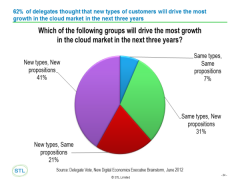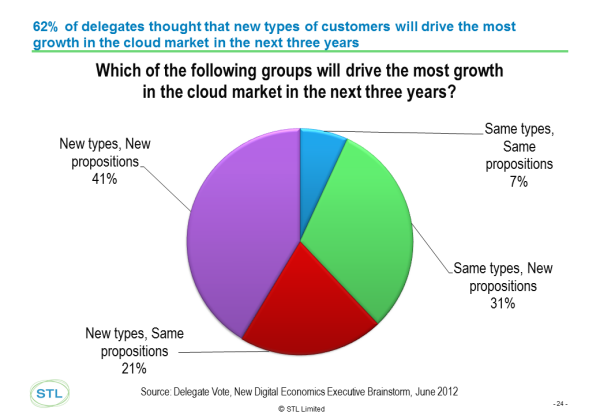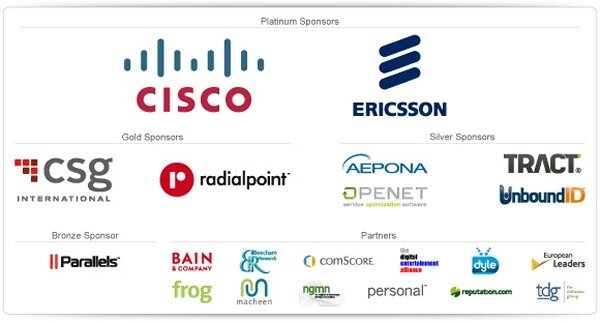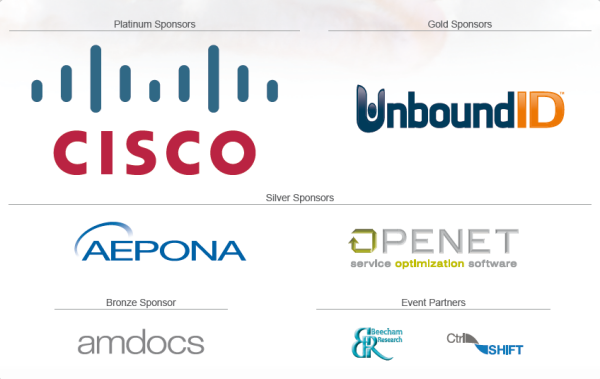|
| Summary: The fight for the Cloud Services market is about to move into new segments and territories. In the build up to the launch of our new strategy report, ‘Telco strategies in the Cloud’, we review perspectives on this shared at the 2012 EMEA and Silicon Valley Executive Brainstorms by strategists from major telcos and tech players, including: Orange, Telefonica, Verizon, Vodafone, Amazon, Bain, Cisco, and Ericsson (September 2012, , Executive Briefing Service, Cloud & Enterprise ICT Stream). |

|
Below is an extract from this 33 page Telco 2.0 Briefing Report that can be downloaded in full in PDF format by members of the Telco 2.0 Executive Briefing service and the Cloud and Enterprise ICT Stream here. Non-members can subscribe here and for this and other enquiries, please email / call +44 (0) 207 247 5003.
Introduction
As part of the New Digital Economics Executive Brainstorm series, future strategies in Cloud Services were explored at the New Digital Economics Silicon Valley event at the Marriott Hotel, San Francisco, on the 27th March, 2012, and the second EMEA Cloud 2.0 event at the Grange St. Pauls Hotel on the 13th June 2012.
At the events, over 200 specially-invited senior executives from across the communications, media, retail, finance and technology sectors looked at how to make money from cloud services and the role and strategies of telcos in this industry, using a widely acclaimed interactive format called ‘Mindshare’.
This briefing summarises key points, participant votes, and our high-level take-outs from across the events, and focuses on the common theme that the cloud market is evolving to address new customers, and the consequence of this change on strategy and implementation. We are also publishing a comprehensive report on Cloud 2.0: Telco Strategies in the Cloud.
To share this article easily, please click:
Executive Summary
The end of the beginning
The first phase of enterprise cloud services has been dominated by the ‘big tech’ and web players like Amazon, Google, and Microsoft, who have developed highly sophisticated cloud operations at enormous scale. The customers in this first round are the classic ‘early adopters’ of enterprise ICT – players with a high proportion of IT genes in their corporate DNA such as Netflix, NASA, Silicon Valley start ups, some of the world’s largest industrial and marketing companies, and the IT industry itself. There is little doubt that these leading customers and major suppliers will retain their leading edge status in the market.
The next phase of cloud market development is the move into new segments in the broader market. Participants at the EMEA brainstorm thought that a combination of new customers and new propositions would drive the most growth in the next 3 years.

These new segments comprise both industries and companies outside the early adopters in developed markets, and companies in new territories in emerging and developing markets. These customers are typically less technology oriented, more focused on business requirements, and need a combination of de-mystification of cloud and support to develop and run such systems.
Closer to the customer
There are opportunities for telcos in this evolving landscape. While the major players’ scale will be hard to beat, there are opportunities in the new segments in being ‘closer to the customer’. This involves telcos leveraging potential advantages of:
- existing customer relationships, existing enterprise IT assets, and channels to markets (where they exist);
- geographical proximity, where telcos can build, locate and connect more directly to overcome data sovereignty and latency issues.
Offering unique, differentiated services
Telcos should also be able to leverage existing assets and capabilities through APIs in the cloud to create distinctive offerings to enterprise and SME customers:
- Network assets will enable better management of cloud services by allowing greater control of the network components;
- Data assets will enable a wider range of potential applications for cloud services that use telco data (such as identification services);
- And communications assets (such as APIs to voice and messaging) will allow communications services to be built in to cloud applications.
Next steps for telcos
- Telcos need to move fast to leverage their existing relationships with customers both large and small and optimise their cloud offerings in line with new trends in the enterprise ICT market, such as bring-your-own-device (BYOD).
- Customers are increasingly looking to outsource business processes to cut costs, and telcos are well-placed to take advantage of this opportunity.
- Telcos need to continue to partner with independent software vendors, in order to build new products and services. Telcos should also focus on tight integration between their core services and cloud services or cloud service providers (either delivered by themselves or by third parties.) During the events, we saw examples from Vodafone, Verizon and Orange amongst others.
- Telcos should also look at the opportunity to act as cloud service brokers. For example, delivering a mash up of Google Apps, Workday and other services that are tightly integrated with telco products, such as billing, support, voice and data services. The telco could ensure that the applications work well together and deliver a fully supported, managed and billed suite of products.
- Identity management and security also came through as strong themes and there is a natural role for telcos to play here. Telcos already have a trusted billing relationship and hold personal customer information. Extending this capability to offer pre-population of forms, acting as an authentication broker on behalf of other services and integrating information about location and context through APIs would represent additional business and revenue generating opportunities.
- Most telcos are already exploring opportunities to exploit APIs, which will enable them to start offering network-as-a-service, voice-as-a-service, device management, billing integration and other services. Depending on platform and network capability, there are literally hundreds of APIs that telcos could offer to external developers. These APIs could be used to develop applications that are integrated with telcos’ network product or service, which in turn makes the telco more relevant to their customers.
We will be exploring these strategies in depth in Cloud 2.0: Telco Strategies in the Cloud and at the invitation only New Digital Economics Executive Brainstorms in Digital Arabia in Dubai, 6-7 November, and Digital Asia in Singapore, 3-5 December, 2012.
Key questions explored at the brainstorms and in this briefing:
- How will the Cloud Services market evolve?
- Which customer and service segments are growing fastest (Iaas, PaaS, SaaS)?
- What are the critical success factors to market adoption?
- Who will be the leading players, and how will it impact different sectors?
- What are the telcos' strengths and who are the most advanced telcos today?
- Which aspects of the cloud services market should they pursue first?
- Where should telcos compete with IT companies and where should they cooperate?
- What must telcos do to secure their share of the cloud and how much time do they have?
Stimulus Speakers/Panelists
Telcos
- Peter Martin, Head of Strategy, Cloud Computing, Orange Group
- Moisés Navarro Marín, Director, Strategy Global Cloud Services, Telefonica Digital
- Alex Jinivizian, Head of Enterprise Strategy, Verizon Enterprise Solutions
- Robert Brace, Head of Cloud Services, Vodafone Group
Technology Companies
- Mohan Sadashiva, VP & GM, Cloud Services, Aepona
- Gustavo Reyna, Solutions Marketing Manager, Aepona
- Iain Gavin, Head of EMEA Web Services, Amazon
- Pat Adamiak, Senior Director, Cloud Solutions, Cisco
- Charles J. Meyers, President, Equinix Americas
- Arun Bhikshesvaran, CMO, Ericsson
- John Zanni, VP of Service Provider Marketing & Alliances, Parallels
Consulting & Industry Analysis
- Chris Brahm, Partner, Head of Americas Technology Practices, Bain
- Andrew Collinson, Research Director, STL Partners
With thanks to our Silicon Valley 2012 event sponsors and partners:

And our EMEA 2012 event sponsors:

To read the note in full, including the following sections detailing support for the analysis...
- Round 2 of the Cloud Fight
- Selling to new customers
- What channels are needed?
- How will telcos perform in cloud?
- With which services will telcos succeed?
- How can telcos differentiate?
- Comments on telcos’ role, objectives and opportunities
- Four telcos’ perspectives
- Telefonica Digital – focusing on business requirements
- Verizon – Cloud as a key Platform
- Orange Business Services – communications related cloud
- Vodafone – future cloud vision
- Techco’s Perspectives
- Amazon – A history of Amazon Web Services (AWS)
- Cisco – a world of many clouds
- Ericsson – the networked society and telco cloud
- Aepona – Cloud Brokerage & ‘Network as a Service’ (NaaS)
- The Telco 2.0™ Initiative
...and the following figures...
- Figure 1 - Bain forecasts for business cloud market size
- Figure 2 - Key barriers to cloud adoption
- Figure 3 - Identifying the cloud growth markets
- Figure 4 - Requirements for success
- Figure 5 - New customers to drive cloud growth
- Figure 6 - How to increase revenues from cloud services
- Figure 7 - How to move cloud services forward
- Figure 8 – Enterprise cloud channels
- Figure 9 - Small businesses cloud channels
- Figure 10 – Vote on Telco Cloud Market Share
- Figure 11 - Telcos’ top differentiators in the cloud
- Figure 12 - The global reach of Orange Business
- Figure 13 - The telco as an intermediary
- Figure 14 - Vodafone’s vision of the cloud
- Figure 15 - Amazon Web Services’ cloud infrastructure
- Figure 16 – Cisco’s world of many clouds
- Figure 17 - Cloud traffic in the data centre
- Figure 18 – Ericsson’s vision for telco cloud
- Figure 19 - Summary of Ericsson cloud functions
- Figure 20 - Aepona Cloud Services Broker
- Figure 21 - How to deliver network-enhanced cloud services
...Members of the Telco 2.0 Executive Briefing Subscription Service and the Cloud and Enterprise ICT Stream can download the full 33 page report in PDF format here. Non-Members, please subscribe here. For this or other enquiries, please email / call +44 (0) 207 247 5003.
Companies and technologies covered: Telefonica, Vodafone, Verizon, Orange, Cloud, Amazon, Google, Ericsson, Cisco, Aepona, Equinix, Parallels, Bain, Telco 2.0, IaaS, PaaS, SaaS, private cloud, public cloud, telecom, strategy, innovation, ICT, enterprise.

![]()
